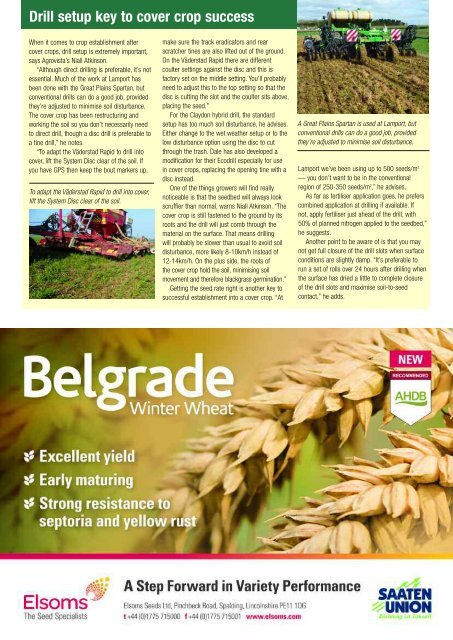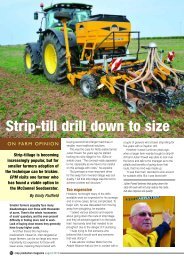You also want an ePaper? Increase the reach of your titles
YUMPU automatically turns print PDFs into web optimized ePapers that Google loves.
Drill setup key to cover crop success<br />
When it comes to crop establishment after<br />
cover crops, drill setup is extremely important,<br />
says Agrovista’s Niall Atkinson.<br />
“Although direct drilling is preferable, it’s not<br />
essential. Much of the work at Lamport has<br />
been done with the Great Plains Spartan, but<br />
conventional drills can do a good job, provided<br />
they’re adjusted to minimise soil disturbance.<br />
The cover crop has been restructuring and<br />
working the soil so you don’t necessarily need<br />
to direct drill, though a disc drill is preferable to<br />
a tine drill,” he notes.<br />
“To adapt the Väderstad Rapid to drill into<br />
cover, lift the System Disc clear of the soil. If<br />
you have GPS then keep the bout markers up,<br />
To adapt the Väderstad Rapid to drill into cover,<br />
lift the System Disc clear of the soil.<br />
make sure the track eradicators and rear<br />
scratcher tines are also lifted out of the ground.<br />
On the Väderstad Rapid there are different<br />
coulter settings against the disc and <strong>this</strong> is<br />
factory set on the middle setting. You’ll probably<br />
need to adjust <strong>this</strong> to the top setting so that the<br />
disc is cutting the slot and the coulter sits above,<br />
placing the seed.”<br />
For the Claydon hybrid drill, the standard<br />
setup has too much soil disturbance, he advises.<br />
Either change to the wet weather setup or to the<br />
low disturbance option using the disc to cut<br />
through the trash. Dale has also developed a<br />
modification for their Ecodrill especially for use<br />
in cover crops, replacing the opening tine with a<br />
disc instead.<br />
One of the things growers will find really<br />
noticeable is that the seedbed will always look<br />
scruffier than normal, warns Niall Atkinson. “The<br />
cover crop is still fastened to the ground by its<br />
roots and the drill will just comb through the<br />
material on the surface. That means drilling<br />
will probably be slower than usual to avoid soil<br />
disturbance, more likely 8-10km/h instead of<br />
12-14km/h. On the plus side, the roots of<br />
the cover crop hold the soil, minimising soil<br />
movement and therefore blackgrass germination.”<br />
Getting the seed rate right is another key to<br />
successful establishment into a cover crop. “At<br />
A Great Plains Spartan is used at Lamport, but<br />
conventional drills can do a good job, provided<br />
they’re adjusted to minimise soil disturbance.<br />
Lamport we’ve been using up to 500 seeds/m 2<br />
–– you don’t want to be in the conventional<br />
region of 250-350 seeds/m 2 ,” he advises.<br />
As far as fertiliser application goes, he prefers<br />
combined application at drilling if available. If<br />
not, apply fertiliser just ahead of the drill, with<br />
50% of planned nitrogen applied to the seedbed,”<br />
he suggests.<br />
Another point to be aware of is that you may<br />
not get full closure of the drill slots when surface<br />
conditions are slightly damp. “It’s preferable to<br />
run a set of rolls over 24 hours after drilling when<br />
the surface has dried a little to complete closure<br />
of the drill slots and maximise soil-to-seed<br />
contact,” he adds.



